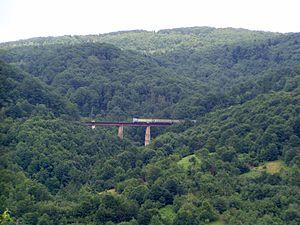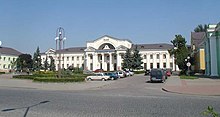Lviv – Sambir – Chop railway line
| Lviv – Sambir – Chop | |||||||||||||||||||||||||||||||||||||||||||||||||||||||||||||||||||||||||||||||||||||||||||||||||||||||||||||||||||||||||||||||||||||||||||||||||||||||||||||||||||||||||||||||||||||||||||||||||||||||||||||||||||||||||||||||||||||||||||||||||||||||||||||||||||||||||||||||||||||||||||||||||||||||||||||||||||||||||||||||||||||||||||||||||||||||||||||||||||||||||||||||||||||||||||||||||||||||||||||||||||||||||||||||||||||||||||||||||||||||||||||||||||||||||||||||||||||||||||||||||||||||||
|---|---|---|---|---|---|---|---|---|---|---|---|---|---|---|---|---|---|---|---|---|---|---|---|---|---|---|---|---|---|---|---|---|---|---|---|---|---|---|---|---|---|---|---|---|---|---|---|---|---|---|---|---|---|---|---|---|---|---|---|---|---|---|---|---|---|---|---|---|---|---|---|---|---|---|---|---|---|---|---|---|---|---|---|---|---|---|---|---|---|---|---|---|---|---|---|---|---|---|---|---|---|---|---|---|---|---|---|---|---|---|---|---|---|---|---|---|---|---|---|---|---|---|---|---|---|---|---|---|---|---|---|---|---|---|---|---|---|---|---|---|---|---|---|---|---|---|---|---|---|---|---|---|---|---|---|---|---|---|---|---|---|---|---|---|---|---|---|---|---|---|---|---|---|---|---|---|---|---|---|---|---|---|---|---|---|---|---|---|---|---|---|---|---|---|---|---|---|---|---|---|---|---|---|---|---|---|---|---|---|---|---|---|---|---|---|---|---|---|---|---|---|---|---|---|---|---|---|---|---|---|---|---|---|---|---|---|---|---|---|---|---|---|---|---|---|---|---|---|---|---|---|---|---|---|---|---|---|---|---|---|---|---|---|---|---|---|---|---|---|---|---|---|---|---|---|---|---|---|---|---|---|---|---|---|---|---|---|---|---|---|---|---|---|---|---|---|---|---|---|---|---|---|---|---|---|---|---|---|---|---|---|---|---|---|---|---|---|---|---|---|---|---|---|---|---|---|---|---|---|---|---|---|---|---|---|---|---|---|---|---|---|---|---|---|---|---|---|---|---|---|---|---|---|---|---|---|---|---|---|---|---|---|---|---|---|---|---|---|---|---|---|---|---|---|---|---|---|---|---|---|---|---|---|---|---|---|---|---|---|---|---|---|---|---|---|---|---|---|---|---|---|---|---|---|---|---|---|---|---|---|---|---|---|---|---|---|---|---|---|---|---|---|---|---|---|---|---|---|---|---|---|---|---|---|---|---|---|---|---|---|---|---|---|---|---|---|---|---|---|---|---|---|---|---|---|---|---|---|---|---|---|---|---|---|---|---|---|---|---|---|---|---|---|---|---|---|---|---|---|---|---|---|---|---|---|---|---|---|---|
|
Railway viaduct at the Ushok pass
| |||||||||||||||||||||||||||||||||||||||||||||||||||||||||||||||||||||||||||||||||||||||||||||||||||||||||||||||||||||||||||||||||||||||||||||||||||||||||||||||||||||||||||||||||||||||||||||||||||||||||||||||||||||||||||||||||||||||||||||||||||||||||||||||||||||||||||||||||||||||||||||||||||||||||||||||||||||||||||||||||||||||||||||||||||||||||||||||||||||||||||||||||||||||||||||||||||||||||||||||||||||||||||||||||||||||||||||||||||||||||||||||||||||||||||||||||||||||||||||||||||||||||
| Route length: | 288 km | ||||||||||||||||||||||||||||||||||||||||||||||||||||||||||||||||||||||||||||||||||||||||||||||||||||||||||||||||||||||||||||||||||||||||||||||||||||||||||||||||||||||||||||||||||||||||||||||||||||||||||||||||||||||||||||||||||||||||||||||||||||||||||||||||||||||||||||||||||||||||||||||||||||||||||||||||||||||||||||||||||||||||||||||||||||||||||||||||||||||||||||||||||||||||||||||||||||||||||||||||||||||||||||||||||||||||||||||||||||||||||||||||||||||||||||||||||||||||||||||||||||||||
| Gauge : | 1520 mm ( Russian gauge ) | ||||||||||||||||||||||||||||||||||||||||||||||||||||||||||||||||||||||||||||||||||||||||||||||||||||||||||||||||||||||||||||||||||||||||||||||||||||||||||||||||||||||||||||||||||||||||||||||||||||||||||||||||||||||||||||||||||||||||||||||||||||||||||||||||||||||||||||||||||||||||||||||||||||||||||||||||||||||||||||||||||||||||||||||||||||||||||||||||||||||||||||||||||||||||||||||||||||||||||||||||||||||||||||||||||||||||||||||||||||||||||||||||||||||||||||||||||||||||||||||||||||||||
| Power system : | 3000 V = | ||||||||||||||||||||||||||||||||||||||||||||||||||||||||||||||||||||||||||||||||||||||||||||||||||||||||||||||||||||||||||||||||||||||||||||||||||||||||||||||||||||||||||||||||||||||||||||||||||||||||||||||||||||||||||||||||||||||||||||||||||||||||||||||||||||||||||||||||||||||||||||||||||||||||||||||||||||||||||||||||||||||||||||||||||||||||||||||||||||||||||||||||||||||||||||||||||||||||||||||||||||||||||||||||||||||||||||||||||||||||||||||||||||||||||||||||||||||||||||||||||||||||
|
|||||||||||||||||||||||||||||||||||||||||||||||||||||||||||||||||||||||||||||||||||||||||||||||||||||||||||||||||||||||||||||||||||||||||||||||||||||||||||||||||||||||||||||||||||||||||||||||||||||||||||||||||||||||||||||||||||||||||||||||||||||||||||||||||||||||||||||||||||||||||||||||||||||||||||||||||||||||||||||||||||||||||||||||||||||||||||||||||||||||||||||||||||||||||||||||||||||||||||||||||||||||||||||||||||||||||||||||||||||||||||||||||||||||||||||||||||||||||||||||||||||||||
The Lviv – Sambir – Chop railway is a main line in Ukraine . It runs from Lemberg (Lviv), the center of western Ukraine, via Sambir , a regional center in the Ukrainian Sub- Carpathian region, to the Ukrainian border town of Chop at the border triangle of Slovakia- Ukraine- Hungary . The line, with a gauge of 1520 mm (Russian broad gauge), is single-track and the operation is carried out by the Ukrainian railways , in particular the Lvivska Salisnyzja .
history
The line was planned as a strategically important connection between the Austrian Crown Land of Galicia and the Kingdom of Hungary over the Uschok Pass as the "State Railway Line Lemberg - Sambor - Sianki" (Hungarian border) on the basis of Act No. 63 of the Reichsgesetzblatt of June 6, 1901, Construction work began on the section between Lemberg and Sambor in autumn 1901, and between Sambor and the border with the Kingdom of Hungary near Sianki a year later. The sections were then opened as follows:
- Lemberg - Sambor (77 kilometers): August 27, 1903
- Sambor - Strzyłki (36 kilometers): November 19, 1904
- Strzyłki - Sianki (62 kilometers): August 24, 1905

The line from the Hungarian side was also completed in accordance with a Hungarian law of 1904 on October 2, 1905 starting from Nagyberezna , the section between Csap and Ungvár was opened by the Hungarian Northeast Railway on August 28, 1872 and became the property of the Hungarian State Railways in 1890 over. In 1894, the line (41.9 kilometers) from Ungvár to Nagyberezna was continued by the later Ungthal-Local-Eisenbahn-Actien-Gesellschaft ("Ungvölgyi helyi érdekü vasút"). From 1905 the operation was carried out by the Hungarian State Railways, in 1908 the Section entirely nationalized.
After the end of the First World War in 1918, the section to Sianki came to Poland , the remainder to what is now Čop to Czechoslovakia , here the section was run under number 282 to Užok .
Due to the occupation of the southern part of Carpathian Ukraine as a result of the First Vienna Arbitration Award by Hungary, the remaining Domanice-Polish border line was separated from the rest of the route network and could no longer be served. After the connection of the entire Carpathian Ukraine, the Hungarian Railways took over the operation on the former Czechoslovakian lines. Due to the occupation of eastern Poland by the Soviet Union shortly after the start of the Second World War in 1939, the Polish part of the line also came into the possession of the Soviet railways , which immediately began to re-gauge individual lines, but this was reversed after Germany's attack on the Soviet Union in 1941 made and subordinated the routes of the Eastern Railway . The Lemberg – Sambor – Sianki line was given the number 534c.
The end of the Second World War brought with it the annexation of both Eastern Poland and Carpathian Ukraine to the Soviet Union, border controls in the Carpathian Mountains fell away and, under the leadership of the Soviet railways, all standard-gauge railways were switched to broad gauge, since then the railway has been in broad gauge .
literature
- History of the railways of the Austro-Hungarian monarchy . Editing by Hermann Strach, Vienna, Budapest 1908 ff., Multi-volume standard work at the time
Individual evidence
- ↑ Reichsgesetzblatt of June 6, 1901, No. 63
- ↑ History of the Austrian-Hungarian Monarchy's own railways (1908) - Volume 5, p. 120.
- ↑ History of own tracks of the Austro-Hungarian Empire (1908) - Volume 5, S. 126th
- ↑ http://www.pospichal.net/lokstatistik/55608-ungv%C3%B6lgy.htm
- ↑ http://www.securityprinting.org/akcie/obory/010/30100_002.htm
- ↑ http://www.parostroj.net/historie/Zeleznice_Slov_P_Rus/Slovensko.htm#1
- ↑ http://www.pkjs.de/bahn/Kursbuch1944/Teil6/534c.jpg


